Honey, the shed is in the wrong place. :-( Or August transplanting :-)
We're planning on adding a utility shed to our back yard. I had it all staked out and ready to turn in the application for the permit when the wife brought up some concerns. We would be losing the ability to 'drive thru' from the front to back yard and end up with a large space between the old garden shed and the new utility shed. So we moved the stakes and of coarse the reason I didn't do it this way in the first place became apparent. There would be a tree in front of where the riding lawn mower door would be. But it was a superior location for the shed, so time to move the 6ft spruce that I brought in last Spring. Not my first choice but really after I thought about it, planting now 'up north' is not the worst idea. We've been experiencing nights in the low 60's and 75 for highs. Day are getting shorter and rains tend to increase by end of August. So maybe transplanting now is not so 'Taboo' as it would be further south. Also the extra time the tree would have to grow more roots this late summer & fall would be a plus and I would think and the tree is not actively growing to any extent on topl so why not?
Step 1. Dig the hole at the new location. Estimated depth same as estimated root ball depth or slightly less. Bigger diameter though.
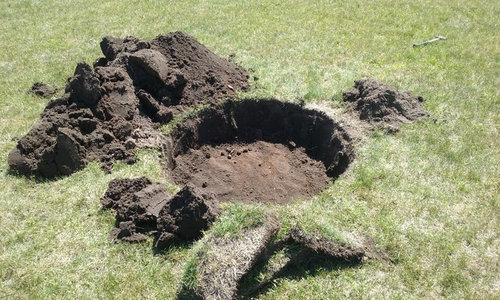
Next pull the stakes, get the mulch off and tools ready. I was surprised to see how much the roots have grown since spring with surface roots out to the original mulch diameter.
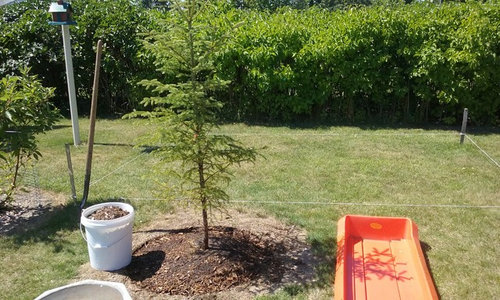
Got it dug around a 32" diameter about a foot deep. I had watered the whole thing earlier so estimated weight was around 300 lbs.

Could lift that much so tipped it up and got some plywood under it and wrapped some nylon strapping around the root ball and pulled it up the ramp using the ATV 4 wheeler. Once I got this far my hand were so muddy I couldn't stop to take pictures. Lost some of the dirt but most of the roots were in the top 10" anyways and the root ball was very dense so I did pretty good with percentage of roots salvaged.
Here is it in the new hole. Again, muddy hands kept me from grabbing the camera so no pictures of the tree on the sled or me pulling it by hand. :-)
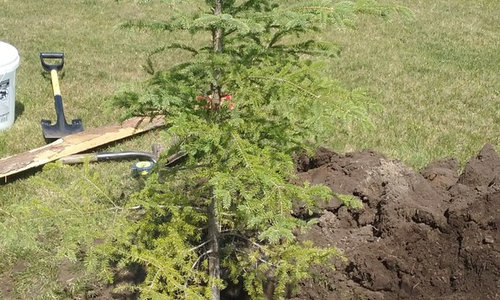
Finished product. Now just have to keep it watered and sprinkle the branches so it doesn't dry out. I've heard that the whole eastern part of the country has been cooler than normal so if that keeps up, I may get away with my August transplant.

And the best part. I no longer have a tree in the way of the new shed.

Comments (68)
User
Original Author5 years ago"What do you get when you cross an engineer"
It's a curse I tell ya. Now I'm even making tree tubes from old milk jugs. lol. :)
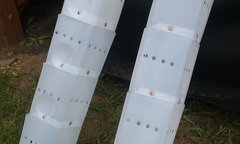
bengz6westmd
5 years agoVery good job, Bill -- looks like a success. This is a white spruce I assume -- nice blue-green color.
User thanked bengz6westmdUser
5 years agoVery nicely done! I wish there were native conifers around here for me to transplant (other than Virginia juniper).
User thanked UserUser
Original Author5 years agoYeah, Picea glauca (white spruce). Serves me right for trying to id a small spruce with out cones to help.
Both this tree and the smaller one that I raised up last spring ended up getting seed cones. I wouldn't have expected this. It must have something to do with the fact they were both put under a lot of stress last year? I have larger, older WS here that have not coned yet. :?
White spruce do really well here, the one in the front yard put on 16" of new growth on the main leader for the 3rd year in a row :^) (It was 12" tall when planted 5 years ago).

- User thanked Ontario_Canada5a_USDA4b
bengz6westmd
5 years agolast modified: 5 years agoYes, I got a southwestern white pine that put out oodles of male cones the next spring after I planted it, but didn't put out any more until just this past spring -- 12 yrs later. Transplant stress......
User
Original Author5 years agoaha! It's what I thought then beng.
I had a large diameter, 75 ft. white spruce that coned profusely one year. So many cones the top looked brown from a distance. The following year it toppled in a storm. Looking at the uprooted portion, it appeared to be some sort of root rot.
That tree, the source of all my seedling spruce that I transplanted all over the 40 acres, some of which are large trees today. And the ones brought to this new place in town.
The woods along that side of the 40 is still riddled with smaller WS from seedling size to 40 ft., in my mind, all are attributed to that "Old Grandpa" tree.
bengz6westmd
5 years agolast modified: 5 years agoBill, it may have seen suffering from the rot, and responded by coning profusely, attempting to spread its seeds while it still could. I see the same thing here w/the ashes as they die -- seedling ashes are everywhere. Slippery elms seem to do it naturally long before they die from DED, so they are common as small trees despite the disease.
White spruces can grow down here, but it's at their "warm" limit. Here's a couple (almost certainly planted) in south-central PA:
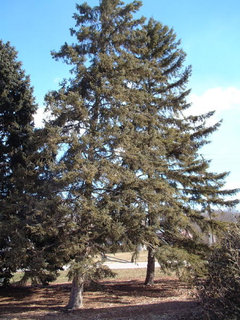 User thanked bengz6westmd
User thanked bengz6westmdUser
Original Author5 years agoThey sure like it around here. Here's a 4 footer I transplanted around 3 to 4 years ago as a 2 footer. It's now almost 6 ft. after putting on over 18" just this season. It Looks like it wants to start branching out, off the new growth. It may grow even more depending on rainfall this year. No fertilizer at all, just water when getting dry. You can't fight mother nature. :^)
Main leader:
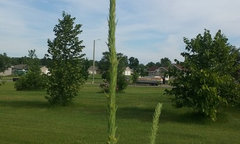
Whole tree:

:^)
whaas_5a
5 years agolast modified: 5 years agoNice was just admiring white sprice growth here as well. If they get at least average rainfall they grow as fast as Norway.
ditto on the that black loam!
User thanked whaas_5aUser
Original Author5 years agolast modified: 5 years ago"Immaculate job. Well done Bill. Wish my soil looked like yours."
"ditto on the that black loam!"
Thanks Garen, whaas,
It looks good, probably better than it really is (silty sand 27/70 guessing). And as long as there is moisture in it, it's fine. Actually seems kind of muddy and sticky and makes your hands black when working in it. But when you get a week or so like we're had with wind, sun and no rain, it doesn't take long for things to slow down and stop growing. That can really hurt when new growth is coming on the trees in May and June.
I'm not complaining, the near beach sand I have on the other place, won't grow hardly anything even when there was water from rain, maybe a few anemic looking weeds. Of coarse there are parts of that land where the soil varies, low dips and a clay pocket or two but those areas can become plenty muddy/wet when rain is plentiful.
The good part about this new place is that things do grow quite well when water is available. But even after the 3" rain we had 2 weeks ago, I was watering some of the trees about a week after that. Sandy underneath so it just drains away with no reserves.
I installed a water faucet at the front of the house this spring. There wasn't any when we bought the house, just one on the back side. Now I don't have to drag 200 ft. of hose around from the back yard to water the front yard trees anymore. My new little Gleditsia seedling is out there. :-)
I also bought a 50 gal. rain barrel. The garden club from this town was offering them for $25 the first year we moved here. I had to change out the faucet as the one that came with the barrel ran so slow when it got down to half full or less. I replaced it with a 3/4" ball valve. Now she runs good all the way to empty. 10 seconds to fill a 2 gal watering can. :)
I use the rain water mostly for the Hemlock. I water that tree every 3-4 days because there's nothing that stays 'consistently moist' around here. I can get 2 or 3 times watering using 15 or so gallons each time so it will last up to a week and a half. And that tree loves water.
The city engineer assured me that the chlorine levels in the city water are very low and that by using a sprinkler, most of the chlorine will be dissipated before the water hits ground but I still use rain water as much as I can for that tree. If prolonged drought, I have used city water, without apparent harm to the tree but still. I sometimes fill the barrel with the hose and let the water warm and chlorine dissipate if it doesn't rain in time.
The rest of the trees get the hose and spray head. I don't water those as often as last year, maybe every week or so but it's still early and could get really dry here by end of summer. Since the 3" 2 weeks ago, we got 0.6" last night with another couple tenths just now with more forecast for tonight. I'm always under the shadow of possible drought here, we have had them in the distant past, but at least I have a way to water things and hopefully severe long term drought stays more of a fear than a reality.
conifer50
5 years agoDo White spruce ever have cones opening as early as August? This one is Fort Yukon, AK opened in July and I don't think that's close to normal. Photo taken Today!
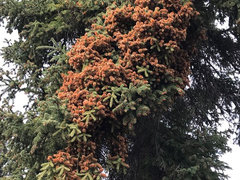
I tried to start a new "thread" but had not luck???User thanked conifer50User
Original Author5 years agoThat looks like a witches broom.
no, cones are still green on many trees although some are getting a purple color to them. I don't think we see ripe seeds until September.
conifer50
5 years agolast modified: 5 years agoYes, it may very well be a "witches broom".....canopy cones still green and look normal.
Here's another specimen with such a "heavy load" that canopy may break out!
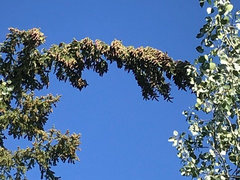
User
Original Author5 years agoMust be a mast year for that one. :-)
This is what the ones on the tree in the OP looks like today. No where near ripe and even less close to opening. :-)
User
Original Author5 years agoLooks like they are just starting to open. Not sure it they are but looks like it.

User
Original Author5 years agoThanks pete. I just removed the stakes from both trees, including the larger one shown earlier in the thread. They're close to being on their own and we're getting to the time of year where everything is hardening off, days are getting shorter, rains should be more frequent and heat stress less of a problem. All in tree time. :-)
User
Original Author4 years agolast modified: 4 years agoTree came through fine. Lower branches getting more growth. No more brown stuff.

The larger tree is on it's own with good growth. Rabbits had their way again with the lower branches even with 2 ft. of chicken wire around it this winter (over 3 ft of snow). :(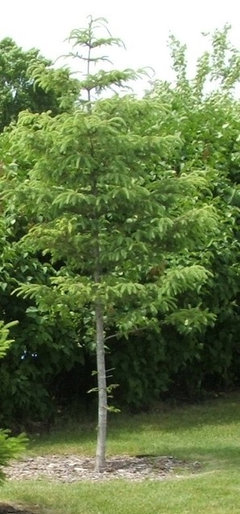
edit: The Picea glauca in the front yard came through with no winter damage.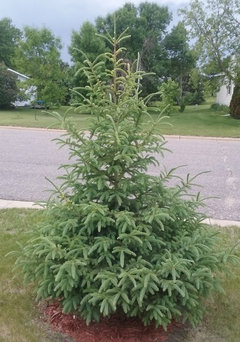
Embothrium
4 years agolast modified: 4 years agoReferring to the tree first talked about here you found new roots because opening winter stem buds sent hormones to the root tips that made them produce new growth. After that spring flush (of roots and shoots) the emphasis in a cold climate adapted tree or shrub shifts to stem growth and other functions of the top, with the next period of major root activity being in fall. Fall in this case being whenever the shoots stop growing and set winter buds. With these matured buds again sending hormones to the roots. This time what happens is existing roots have a period of significant elongation, with 60% of the annual total of increase in length occurring at this time. This phenomenon is one of the main reasons to plant in fall. However full realization of this fall advantage depends on planting before the elongation occurs, and not cutting the roots back in the process - roots cut back in fall will not recover until spring bud break.
User thanked EmbothriumUser
Original Author4 years agolast modified: 4 years agoThanks Embo!
I think I recall you telling me that same thing once before.
So, If I dig/move another woods tree (Picea glauca) this season, should I do it even earlier than early August? Maybe end of July to try and beat the Fall root elongation?
User
Original Author4 years agoNevermind, I'll watch my Picea here in the yard and when the branches are done elongating and the winter buds begin to 'skin up'. If it's sometime by the middle of July, I'll figure I'm good to go. :-)
User
Original Author4 years agoThe new winter buds in the yard are turning brown and it appears that the branches are near the end of elongating. The trees in the woods are generally a little behind the yard trees, but either way, middle to late next week, I'm making the journey. :^)
User
Original Author4 years agoHole preparation done today.
I removed a 15' Green Ash (Fraxinus pennsylvanica) from the area adjacent to the new hole. I had the Ash staked for two years after planting, then noticed some borer holes in the trunk (not EAB), that caused the trunk not to develop properly. So this Picea glauce will be the replacement for that Ash.
Thunderstorms forecast for tonight and tomorrow and possibly rain on Wednesday AM, so by Thursday I should have it home and in the ground.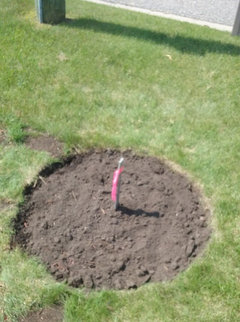
User
Original Author4 years agoGot out in the woods today. Rained over an inch last night and more rain predicted this afternoon. Temps back in the 80's tomorrow so I figured it would be a good day to dig a tree with moist soil and temps in the 60's. The soil was clay loam about 8" deep with pure sand underneath. Most of the roots were in the top soil, very wet conditions with mist in the air.

Glad I only had 20 yds. to drag this thing out to the trailer, including distance up the ramp. This tree grew quite a bit since I spotted it a year ago but the trunk was still under an inch diameter at ground level.
It was a windy ride for the tree on a trailer but without the ramp, I don't think I would've been able to lift the moist clayey dirt ball. I drove 15-20 mph for 16 miles back to the house to keep the wind down.
I hope I wasn't too early digging this one. The main leader wilted an inch or two from the top, by the time I got it planted. There was some insect damage about an inch from the top so we'll have to see if it straightens out. Just got through soaking the root area with several gallons of rain water that I collect.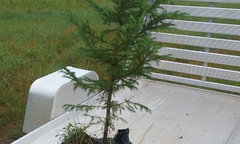 20 mph winds predicted today, that means we'll get 35 mph gusts :-0, so I staked the tree for now even though the root ball was grassy and quite solid. We'll see how the progress for this one does by fall and next spring. By all rights it should be ready to start elongating roots over the next several weeks. :-) Hopefully be better spring growth because of that next year.
20 mph winds predicted today, that means we'll get 35 mph gusts :-0, so I staked the tree for now even though the root ball was grassy and quite solid. We'll see how the progress for this one does by fall and next spring. By all rights it should be ready to start elongating roots over the next several weeks. :-) Hopefully be better spring growth because of that next year.
whaas_5a
4 years agolast modified: 4 years agoNice....thats how the northerners do it.
I’m sure we have a few folks confused as to why you just transplanted an Evergreen in July! lol
I have nine container plants that I had since spring that I’m gonna wait a couple more weeks and then I’m going to plant them - hell no am I going to wait for fallUser thanked whaas_5aUser
Original Author4 years agolast modified: 4 years agoWhaas,
When I moved the first tree in this thread, across the yard, first week of August, I noticed that the roots had already extended out past the planting area, in where the tree was originally transplanted the previous April. So I surmised that the root elongation, that Embothrium eluded to, must have began earlier, possibly weeks earlier, than August, which would put us into the middle of July. Not that far away from what you yourself said whaas, about harvesting conifers by late July.
My goal with this last tree, was to make the move (transplant) before root elongation occurs. As Embo said, to fully realize the advantage of roots elongating by up to 60% after winter buds send hormones down, to signal the roots to begin this process.
So sorry if I caused any confusion for anyone with this last transplant. It's just an attempt to see for myself if mid July is the best time to move woody plants (conifers in particular) in my neck of the woods. :-)
bengz6westmd
4 years agoAttractive tree, but moving it in July.... Transplanted a Table Mnt pine w/new sprouts once -- they wilted immediately, but came back up after a few days.
User thanked bengz6westmdUser
Original Author4 years agoThanks beng. Good to know.
Forecast is mid to high 80's the next ten days. So much the for wetter and cooler 3 month forecast made earlier. ;-)
We had 56d f again last night with heavy dew this morning so that all helps.
User
Original Author4 years agolast modified: 4 years agoJust for every ones information:
I wanted to move this tree back in April, before bud break, because I feel this is 'thee' absolute best time. You get new root growth in the spring and root elongation again in late summer/fall, without having to work the roots during hot weather.
I was unable to do that back then, so I thought this would be the next best method without waiting until next year. And that being because we have a much cooler climate and shorter season in my area.
This can be a gamble because we can get stretches of hot humid nights lasting for weeks but this is rare. Generally in my area, temperatures at night that fall into the 50's & 60's. AC goes off and we open the windows at bedtime.
So I'm banking on this and plenty of water to make this one work. Wish me luck. :-)
maackia
4 years agoBill, I admire your curiosity and tenacity. You missed the optimal time to move it, so you’re gambling and trans-planting as we (at least here in west-central WI) are in the warmest/driest part of summer. Second guessing is easy to do, and I would’ve moved it just prior to the “mist in the air” conditions. Still, I’ll wager the White Spruce comes through just fine. They are tough and tolerant. Thanks for sharing it.
User thanked maackiawhaas_5a
4 years agoJuly to August is the second best time to transplant an evergreen In WI. Definitely July for you.
The hormones are still active so those roots you tore will generate new roots. New roots will generate from existing roots in fall.
Transplanting (digging up or otherwise root surgery) is not advised for fall In very cold climates. The roots you tore won’t regenerate so you’re counting on existing roots elongation only.
Two issues here -
1) In wet winters you can experience root rot of those cut roots
2) Winters are brutal here - it’s easier to baby a plant in summer vs winter
I transplanted 6 Serbian spruce in July last year. Although they had some burn which is expected with -26 they’re looking pretty goodUser thanked whaas_5aUser
Original Author4 years agolast modified: 4 years agoThanks whaas, I didn't know new roots could still form this late, that would be nice!
I'm thinking too, maackia , White spruce isn't real sensitive and is acclimated to this climate. The tree doesn't look very stressed so far and Farmers are used to takng gambles. :-)
63 d(f) last night, NW breeze, Calm & 100% relative humidity with light sprinkles this morning. Lows predicted 10 day, low to mid 60's with highs low to mid 80's. TS predicted Sunday night. One hot day (for us anyways) 89 f on Monday.
User
Original Author4 years agolast modified: 4 years agoJust a little browning on the thin little branches near the bottom of the tree, those branches that were residing in the tall grass when the tree lived in the woods and aren't too developed. Not too bad though.
The same thing that happened to the first tree in this thread when I moved it across the yard. That one sent out new growth the next spring and all the brown is gone now after second spring in it's new location.
Otherwise this new tree looks good, the leader straightened up and winter buds are present. This area gets all the snow shoveled/blown from the both driveways on either side and there's mulch around the tree, so root protection is about as good as it gets in this location.
I've watered frequently in between rains and nights are cooling into the 40's & 50's with daytime highs in the 70's F. :-)

User
Original Author4 years agoYes, when you get extreme cold temps like we do, you look for any help you can get. :-)
User
Original Author3 years agoJust a quick followup.
The tree came through winter okay except that those layers of snow must've shifted and a foot of the top leader was broke when the snow melted.
The most concerning part, when I looked last fall, the winter buds didn't look completely developed. They were pretty green when I dug the tree and didn't appear to progress much during the rest of the season. So I don't know if I hurt the buds by digging the tree at that time?
Now this spring, there's very little bud break so I don't think there will be much growth this season. The bud break is uniform, just very small amount coming out green. But it's alive.
I'll try to show growth later this season, I'm sure it won't be anything to brag about. :-)
BillMN-z-2-3-4
last yearlast modified: last yearUpdate: 12-9-22
The Picea glauca (spring of 2021), spoken about in the last couple of posts, looked a little off with about 1-1/2ft. of top main leader broken off from the compacted snow load from both residences piling on top all winter then melting and settling down like an iceberg, taking the main leader with it.
It's very narrow between our driveways so the snow gets piled pretty deep there.
Early spring of 21, I noticed one of the top branches that were left began to 'curl' upward, like it wanted to take the place of the broken leader. I've seen this before with damaged leaders on my Hemlock, but this would be a first for white spruce. (eta: added picture taken 5-17-21 below).
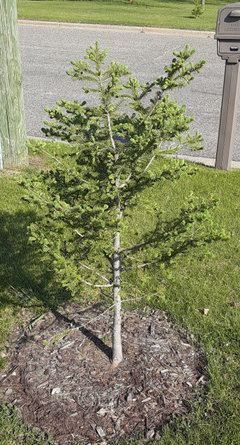
Anyways, I took a 24"L. steel rod, 3/8" dia. and tied one end several inches below the old break and bent the volunteer branch upward to the top of the steel rod and tied it there too in several places. This picture is from August 2021 so the new growth is already hardening off. It really looked better than expected.
Removed the stake for winter '2021-22 but then the unexpected happened. By now my neighbor caught on to the idea that they could blow their snow on top of my little tree to aid in having enough place for them to put their snow. :-/By mid-winter it looked a lot like the winter before and in my mind, I knew it was destined for disaster again in the following spring.
So, some time in February 2022, I took the time to dig around the tree in hopes of preventing further damage. You can see the tree was showing signs of bending over with two feet of compacted, frozen snow resting at the top of the pile.

The property line is the center of the utility pole and the neighbor only has about 3-4 feet from the line to the edge of their driveway, so they really have no business putting much snow at all on my side of the line. I think sometimes they have friends do their snow removal they don't have a clue to what's going on.I did tell her why I was doing this, when she saw me shoveling and asked what I was doing and hopefully educated her about snow loads crushing my tree.
Anyways, crisis averted; the tree grew normally season of 2022.
Here it is today 12-9. I'll have to keep an eye on it this winter and possibly a few more (not every year we have this much snow).
Big storm forecast for Tue-Wed-Thurs. 12+" possible. Bring it on! :^)
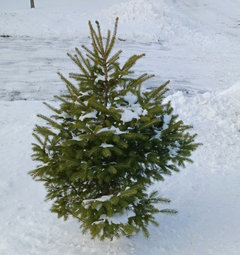
cyn427 (z. 7, N. VA)
11 months agoYay for you and your little, very resilient Picea. This was a grat read!
BillMN-z-2-3-4
11 months agoPicea glauca tend to root very shallow.
Below, a P.g. I transplanted as a small sapling, 40+ years ago. It's at the top of a slope, that drops down into a wet area about 10+ ft. away (toward top of picture). Picture from 11-2019.

bengz6westmd
11 months agolast modified: 11 months agoWell, that p,g, doesn't have girdled roots -- be nice to see a full view of that tree. I planted some Norway spruces over 40 yrs ago. I'm long gone from that house -- but they're fine trees today.
BillMN-z-2-3-4
11 months agolast modified: 11 months agoCan't find anything more of the last picture posted. It was one of about 8-10 P.g. that I planted at my old place along the field. They grew up on the north side of a bunch of brush and trees, so those spruce stretched up pretty tall.
As an aside: When I first moved to my old place, there were a couple, very small J. virginiana growing wild there. I moved them, more than once.
Later in life after my son bought the place, he decided to clear part of the old yard for other interests. Those red-cedar were cut down, hauled to the sawmill. He then used the lumber to make some sort of table.
Finished product of what was a seedling, 'back in the day'. ;-)
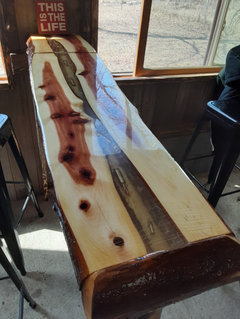
BillMN-z-2-3-4
8 months ago8-6-23: update.
This will be my final Picea Glauca update, all that I have on this thread (8). I'm tired of searching for all these old posts and remembering which is which. I'm done.
Picea glauca. This is the tree that started this thread, the one moved across the yard in August.Height 9-1/2 ft., it's been through some dry times but good growth.

Picea Glauca: The one piled deep with snow by the driveway.Just under 6ft. Mentioned earlier in this thread.
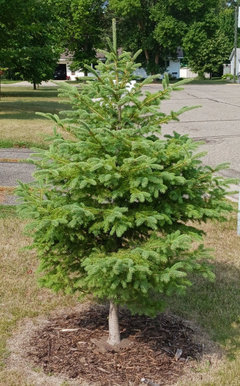
Picea Glauce: Front yard tree, 2013 one of the first trees I planted here.11'-3" Tall. Mentioned earlier in this thread.

Picea Glauca: Also mentioned earlier in this post. The 'Rabbit pruned' one in the back yard.Was 8-9 ft. when first brought in from woods and planted. Now 12' 6".
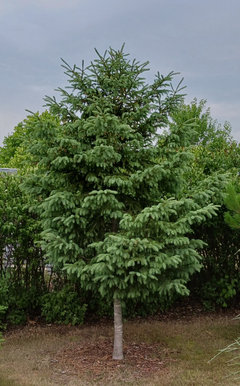
Picea glauca: First tree I planted in the yard 2012. Raised up from sinking too deep in ground. Had some droughts damage a couple years ago and is now 68" tall. Very blue in color. Got watered this season.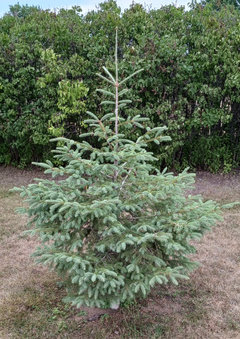
Picea glauca. These were 2 scrubs from the woods (2014-15?) <2 ft. tall.
:-)
bengz6westmd
8 months agoThanks. Might be lighting differences, but some of them are more blue-green than the others.
BillMN-z-2-3-4
8 months agoYou're right beng.
There are distinct variations in color between trees.
Those two P. glauca in the last picture above, were dug in the same area, been growing together for years and the one on the right has a noticeably bluer needle color while the left one is almost straight green.








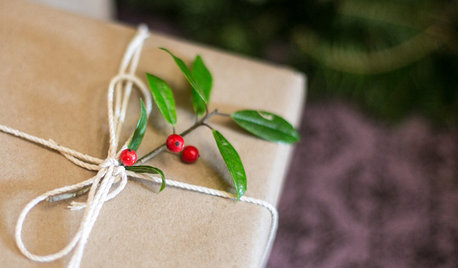













BillMN-z-2-3-4